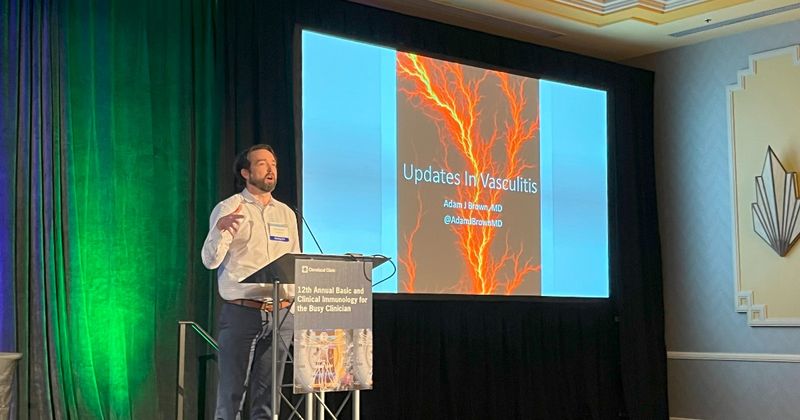‘Astounding amount’ of vasculitis trials opens mixed bag of ‘exciting,’ ‘frustrating’ data
SCOTTSDALE, Ariz. — Recent efforts in vasculitis research have seen both “exciting” and “frustrating” results, according to data presented at the Basic and Clinical Immunology for the Busy Clinician symposium.
“Vasculitis is a really exciting field to be in,” Adam Brown, MD, from the department of rheumatologic and immunologic disease at Cleveland Clinic, told attendees. “There is really an astounding amount of trials going on in a very rare disease.”

These trials are focused primarily on giant cell arteritis (GCA), anti-neutrophil cytoplasmic antibody (ANCA)-associated vasculitis and IgA-associated vasculitis.
One pressing question from the research community is how the Asp358Ala variant of the interleukin (IL)-6 receptor could impact tocilizumab (Actemra, Genentech) response in GCA. “When you have this polymorphism to Asp358Ala, it actually increases the cleavage site to the receptor of IL-6,” Brown said. “It allows the protease to go in and cleave it a whole lot easier.”
Based on this idea, the thought was that patients who have this polymorphism have a change in response to IL-6 antagonism. Investigation into this hypothesis in a data set presented at ACR Convergence 2023 proved this theory to be true, according to Brown.
“This is not a diagnostic process, but it may potentially be a prognostic process,” Brown said. “There are not too many times in rheumatology to determine whether a patient may or may not respond to a certain biologic therapy.”
While further investigation is necessary to further elucidate this association, Brown suggested that it may be “coming around” to the forefront of research.
Regarding ANCA-associated vasculitis, B cell depleting therapies have started gaining attention. For patients who are unable to receive induction using rituximab (Rituxan, Genentech), obinutuzumab (Gazyva, Genentech) has emerged as a viable option.
“There is excitement for other induction therapies for ANCA vasculitis in the future,” Brown said.
Another development in ANCA vasculitis involves C5A receptor antagonism with avacopan (Tavneos, Amgen). Importantly, the C5A receptor is not on the classical or alternative pathways of the complement system; rather, it is on an offshoot of the pathway.
“The beauty of that is that when you are blocking C5A you are no longer blocking the complement cascade,” Brown said.
This proof-of-concept of C5A antagonism in ANCA vasculitis led to the ADVOCATE trial, which, in turn, led to approval of avacopan for this indication.
“Patients on avacopan had less relapses compared to prednisone,” Brown said. “Patients on avacopan also had improvement of the GFR in the kidneys over the course of the year compared with prednisone.”
Despite this result, Brown stressed that there are still questions surrounding the use of avacopan in ANCA vasculitis. “The patients who were the sickest of the sick were not enrolled,” he said.
Further research into this mechanism of action should investigate the efficacy in patients who are most severely impacted by ANCA vasculitis.
Shifting gears, Brown stressed that research investigating IgA vasculitis has yielded less than optimal results. “IgA vasculitis is very frustrating,” he said. “We do not have a good idea how to treat it.”
Data on various forms of immunosuppression are not robust for this disease. “The classical complement pathway does not seem to be a major player in IgA nephropathy,” Brown said.
Moreover, targeting mannan-binding lectin serine peptidase also failed to demonstrate efficacy in this disease.
Researchers have also targeted C5 and C5A on the complement pathway but failed to achieve therapeutic goals.
“It will be a while until we have a better understanding of what inhibitors work best,” Brown said.

